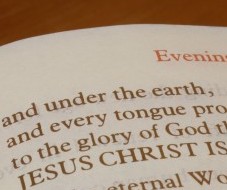Yesterday morning on the news, I saw a brief story about the changes to the Mass that are coming up later this month. It was a pretty neutral piece and just made people aware that a new translation of the Roman Missal will be used beginning on the first Sunday of Advent, November 27th. Of course, all of us here at Notre Dame have been talking about this for quite a while now, and so I don’t think that story was “news” to us, although it was nice to see it covered in the secular media.
Father Steve, the deacons, and I have been preaching about this upcoming change on and off now for a while, but I thought today it might be good to circle back and talk a bit about why the change is happening. So today’s brief homily is going to be an “FAQ” or “Frequently Asked Questions” of sorts about this upcoming change.
The first question we have been hearing is, “Why change the Mass?” And the answer to that is that the Mass is not changing. The fundamental mystery that we celebrate remains the same: the saving sacrifice of our Lord Jesus Christ on the Altar of the Cross, whose Body and Blood we receive to strengthen our witness in the world and lead us to the Banquet of Heaven. Nothing new about that; and there would be no reason to change something so essentially perfect. The structure of the Mass remains the same as well. It is simply that some of the words are being re-translated.
Which brings us to the second question: “Why re-translate the Mass?” Well, after the Second Vatican Council, the Liturgy underwent some adjustments. The most notable adjustment was the permission to celebrate Mass in each country’s local language, known as the vernacular. So every country’s bishops oversaw a translation. This resulted in different versions, some richer, some plainer, some less accurate, some very precise. A secondary result of this was that there was a different version of the Mass in every English-speaking country in the world. Now all were valid, but as a Universal Church, it makes more sense that we should share the same translation for our worship. That is what is happening now; every English-speaking country on the planet will use the same translation of the Mass, and it’s a translation that is truer to the original Latin text.
So that may lead us to another question: “Does this mean that we have been celebrating the Mass wrong all these years?” And the answer to that is simply “no.” Whatever may have been the deficiencies of our current translation, it was a translation made in good faith, and accepted by Rome. We have all prayed it in faith and it has led us to Christ in many splendid ways. There is nothing so deficient in the current translation that would make it invalid. Some say this new translation is a move back toward where we “were” before Vatican II. That is not the case; this is simply a perfection moving us forward in our implementation of that important work.
And that brings up another question: “So if the current translation is valid, why bother changing it?” The reason we are renewing ourselves with a new translation of the Mass is that we always want to be perfecting our participation in the Sacred Liturgy. We’ll never get it completely right this side of the Kingdom of God; the only place worship would ever be done perfectly is in heaven. But that doesn’t mean that we don’t strive for perfection here on earth. So that means constant renewal when renewal is warranted. This re-translation is all about bringing ourselves to more perfect prayer and thus to more perfect union with God Almighty.
So who did the new translation? The International Commission on English in the Liturgy (ICEL) is chartered to prepare English translations of liturgical texts on behalf of the conferences of bishops of English–speaking countries. They presented draft versions to the various English-speaking bishops conferences. They made changes and eventually a version was presented to Vox Clara, a group in Rome charged with seeing to the faithful translation of the Mass into English. At that point the Vatican Congregation for Divine Worship and the Discipline of the Sacraments examined the texts and gave approval for their use. This process was not a quick one; it took over ten years.
So that’s a quick overview of why the Mass is being re-translated. If you have other specific questions, I am happy to answer them. We will have two evenings of preparation to which all are invited; please see the bulletin for the details. It is my prayer that Notre Dame will be as well prepared for the changes as we can be, and that we will celebrate the opportunity to grow in our appreciation of the Sacred Liturgy.
